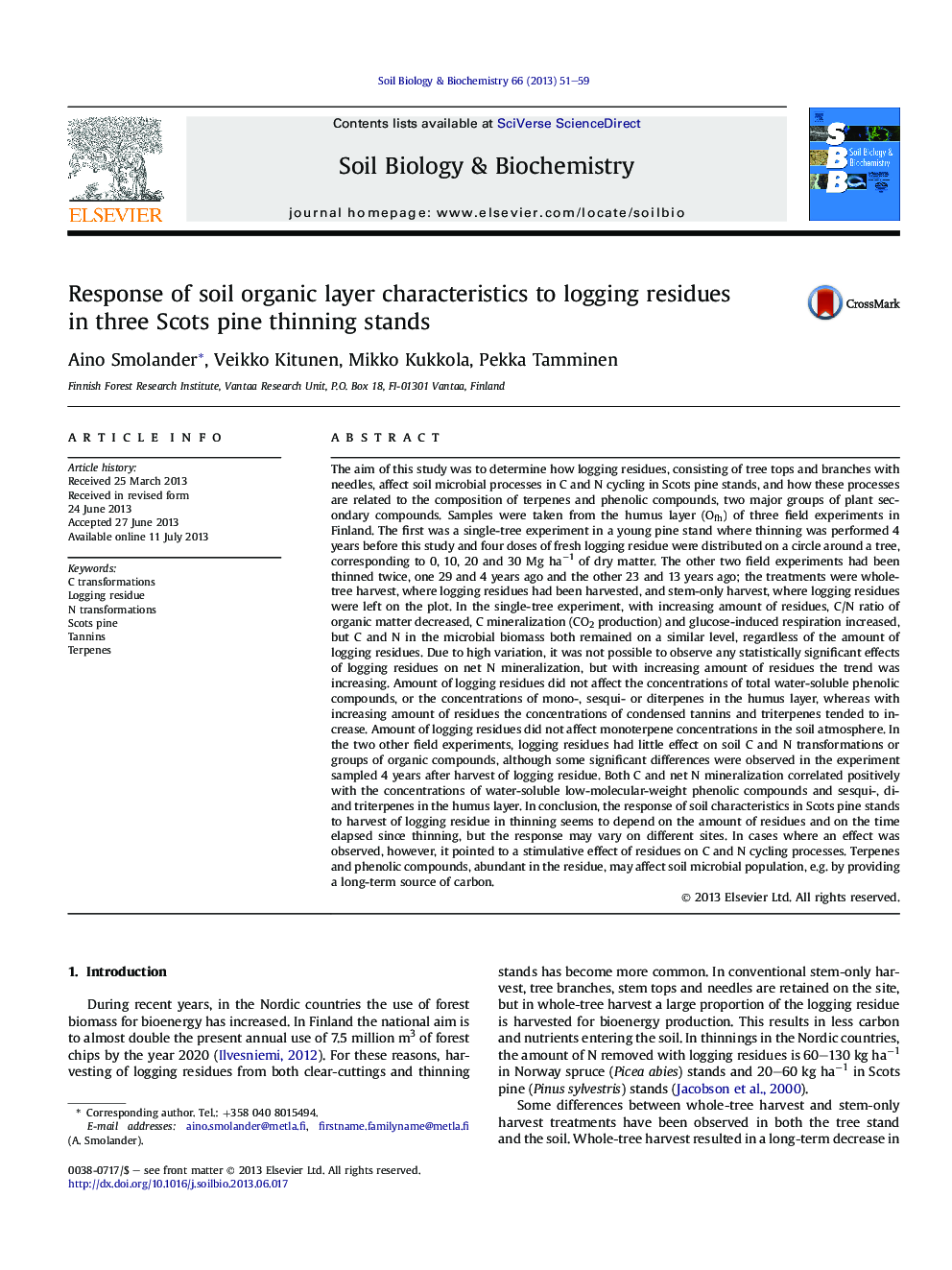| کد مقاله | کد نشریه | سال انتشار | مقاله انگلیسی | نسخه تمام متن |
|---|---|---|---|---|
| 2024681 | 1542618 | 2013 | 9 صفحه PDF | دانلود رایگان |
عنوان انگلیسی مقاله ISI
Response of soil organic layer characteristics to logging residues in three Scots pine thinning stands
دانلود مقاله + سفارش ترجمه
دانلود مقاله ISI انگلیسی
رایگان برای ایرانیان
کلمات کلیدی
موضوعات مرتبط
علوم زیستی و بیوفناوری
علوم کشاورزی و بیولوژیک
دانش خاک شناسی
پیش نمایش صفحه اول مقاله

چکیده انگلیسی
The aim of this study was to determine how logging residues, consisting of tree tops and branches with needles, affect soil microbial processes in C and N cycling in Scots pine stands, and how these processes are related to the composition of terpenes and phenolic compounds, two major groups of plant secondary compounds. Samples were taken from the humus layer (Ofh) of three field experiments in Finland. The first was a single-tree experiment in a young pine stand where thinning was performed 4 years before this study and four doses of fresh logging residue were distributed on a circle around a tree, corresponding to 0, 10, 20 and 30 Mg haâ1 of dry matter. The other two field experiments had been thinned twice, one 29 and 4 years ago and the other 23 and 13 years ago; the treatments were whole-tree harvest, where logging residues had been harvested, and stem-only harvest, where logging residues were left on the plot. In the single-tree experiment, with increasing amount of residues, C/N ratio of organic matter decreased, C mineralization (CO2 production) and glucose-induced respiration increased, but C and N in the microbial biomass both remained on a similar level, regardless of the amount of logging residues. Due to high variation, it was not possible to observe any statistically significant effects of logging residues on net N mineralization, but with increasing amount of residues the trend was increasing. Amount of logging residues did not affect the concentrations of total water-soluble phenolic compounds, or the concentrations of mono-, sesqui- or diterpenes in the humus layer, whereas with increasing amount of residues the concentrations of condensed tannins and triterpenes tended to increase. Amount of logging residues did not affect monoterpene concentrations in the soil atmosphere. In the two other field experiments, logging residues had little effect on soil C and N transformations or groups of organic compounds, although some significant differences were observed in the experiment sampled 4 years after harvest of logging residue. Both C and net N mineralization correlated positively with the concentrations of water-soluble low-molecular-weight phenolic compounds and sesqui-, di- and triterpenes in the humus layer. In conclusion, the response of soil characteristics in Scots pine stands to harvest of logging residue in thinning seems to depend on the amount of residues and on the time elapsed since thinning, but the response may vary on different sites. In cases where an effect was observed, however, it pointed to a stimulative effect of residues on C and N cycling processes. Terpenes and phenolic compounds, abundant in the residue, may affect soil microbial population, e.g. by providing a long-term source of carbon.
ناشر
Database: Elsevier - ScienceDirect (ساینس دایرکت)
Journal: Soil Biology and Biochemistry - Volume 66, November 2013, Pages 51-59
Journal: Soil Biology and Biochemistry - Volume 66, November 2013, Pages 51-59
نویسندگان
Aino Smolander, Veikko Kitunen, Mikko Kukkola, Pekka Tamminen,